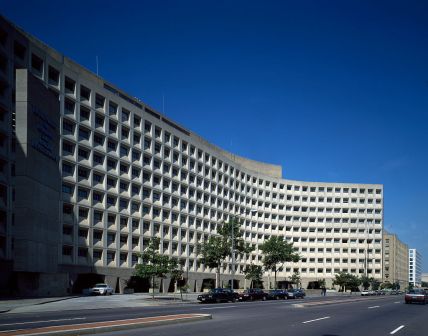 From left to right: Paul Brubaker, Chris Niedermayer, Simon Szykman, David Bray, Karen Evans and Kevin Cooke. (Photo: Colby Hochmuth/FedScoop)
From left to right: Paul Brubaker, Chris Niedermayer, Simon Szykman, David Bray, Karen Evans and Kevin Cooke. (Photo: Colby Hochmuth/FedScoop)Do chief information officers matter?
That was the question posed to six individuals, all of whom have had a career in federal IT management, most of them working in the Office of the Chief Information Officer.
“There are some CIOs who have been fairly successful in implementing technology reforms in their agencies, but it’s getting harder and harder as we burden the system with additional regulations,” said Paul Brubaker, director of planning and performance management in the Office of the Deputy Chief Management Officer at the Defense Department. “It’s a hard job, and we dilute the responsibility with the proliferation of C-level executives.”
The Clinger-Cohen Act of 1996 highlighted the need for CIOs in government and established guidelines for what their roles would entail. However, along the way the script for what a CIO should be has gotten lost along the way, panelists said.
That, combined with an escalated role of technology in government, has called for a new approach to federal IT management completely.
For AFFIRM’s 35th anniversary luncheon Thursday, the panel looked at a issue that has been the subject of congressional hearings, editorials and conversation in the federal IT community: the evolving role of the CIO.
“If technology is moving so quickly, and yet we’re going to have to do mountains of paperwork just to get it, how is that modern IT?” asked David Bray, CIO at the Federal Communications Commission.
In the CIO role since last fall, Bray has quickly become a top thought leader in the federal government. At his own agency, Bray has adopted a unique management style and brought in folks who share his vision of an innovative and transparent agency.
So, what should today’s public service leader look like?
“Technology and the Internet are becoming ubiquitous,” Bray said. “And we have not thought about how has that fundamentally changed public service… Bureaucracy involves a lot of expectation and that creates a lot of friction; when you have someone in a CIO role, they need to be able to manage that risk.”
Big failures, and worse, public failures in federal IT, have created an environment adverse to risk. And healthcare.gov highlighted everything that was wrong with federal IT, according to Karen Evans, national director of the U.S. Cyber Challenge and former e-government and IT administrator at the Office of Management and Budget.
“When a failure like that happens at that magnitude, everyone jumps into compliance and becomes risk averse,” Evans said. “It’s not the law causing this; what ends up happening is that people on both sides become risk averse because they don’t want to end up on Capitol Hill.”
It’s not a matter of the policy or legislation itself, Evans said, but it really comes down to the implementation.
According to Brubaker, it does have a lot to do with those mandating the policy because they are not aware of the effects of the policies they implement. The 535 members of Congress and officials at OMB don’t spend time in the agencies, and they “just do not get the policy implications,” according to Brubaker.
“It’s insane to watch how [regulations] gum up the system, and how we can’t be agile if we want to,” he said. “We’re so wedded to old practices. What’s the first thing GSA thinks about when we start talking about agile development? ‘We’re going to create a vehicle for agile.’”
Much of how CIOs can operate within agencies depends on the culture of that entity. Simon Szykman, CIO at the Commerce Department, has been in a CIO role for seven years. As to the argument of CIOs controlling the purse strings, Szykman said it isn’t the only way to empower CIOs.
“There are other options for strengthening the ability to have control over mission, besides just control over dollars,” Szykman said.
It also has a lot to do with leadership and the cabinet-level executives supporting the IT mission. The Commerce Department is a great example of senior leadership supporting IT initiatives; when Commerce Secretary Penny Pritzker laid out her plan for the agency late last year, opening up the department’s data was a main pillar in that framework.
“When a secretary at an agency cares, everyone else will care too,” Szykman said.
Everyone has the same goal to improve services for the citizens, Evans said. It’s not about just highlighting the failures and shortcomings; the positives are cause for celebration, too.
Chris Niedermayer, senior knowledge officer at BRMi, and Kevin Cooke, acting CIO at the Housing and Urban Development Department, also took part in the panel.






